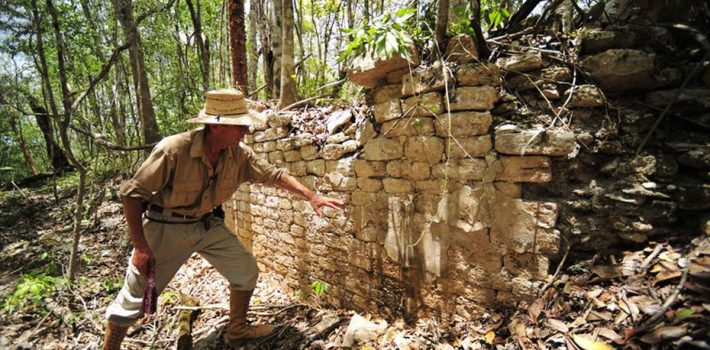Chactún: the discovery of a lost Mayan city
A CITY BURIED IN YUCATAN’S RAINFOREST
A team of archaeologists have found a long lost Mayan city in the rainforests of eastern Mexico (state of Campeche), and they’re hoping the discovery will help them figure out what led to the ancient civilization’s rise and fall centuries ago. The city, which archaeologists have dubbed Chactun or Red Rock, was in its prime between 600 and 900 AD (Classic period), and is made up of 15 pyramids, various plazas, homes and offices for elite members of society, and ball courts, according to Mexico’s National Institute of Anthropology and History (INAH). As many as 40,000 people may have lived in Chactun during its heyday. The city covers about 54 acres of land, and its nearest neighbor is Xpujil, an ancient Mayan town also in ruins, about 10 miles away (and about 75 miles west of Chetumal, the capital city of Quintana Roo). The team that found Chactun was led by archeologist Ivan Sprajc, from the Slovenian Academy of Sciences and Arts. Sprajc told Reuters that the city was completely covered in jungle growth and vegetation when they came across it, but that they have evidence that other people had visited the city about 20 to 30 years ago. “Lumberjacks and gum extractors were certainly already there, because we saw cuts on the trees,” Sprajc said in the report. “What happened is they never told anyone.”
Sprajc and his team went on the hunt for Chactun after looking at some aerial photos of rainforests in the Mexican state of Yucatan. “With aerial photographs examined stereoscopically, we found many features that were obviously architectural remains,” Sprajc said in an institute statement. “From there we took the coordinates and the next step was to locate the ancient alleys used by tappers and loggers to reach the area.” His team spent about three weeks clearing a 10-mile path from Xpujil to reach Chactun, which has been divided into three sections, each of them having their own monuments, the INAH reported. In front of each of the monuments, Sprajc said that his team has found ceramic offerings, which show that these might have been places of worship.
The archaeologist and epigraphist Octavio Esparza Olguin signaled that epigraphic registries are not abundant in this region, which is why the pieces found are of such importance. The expert in epigraphy, who is part of the expedition endorsed by the INAH, and who advanced deep into the Biosphere Reserve of Calakmul, explained that from the pieces found at the site, three are in a good state of conservation, and seven still allow the observation of hieroglyphic writing, although its conservation state is so precarious that events and precise dates are difficult to appreciate. Another nine remain severely eroded. Esparza Olguien said that it’s exceptional that Stele 1 still has stucco remains, because this material is rarely conserved in tropical weather after so long. The piece gives name to the place, since it makes reference to a “Red Stone” or “Big Stone”, which was set up by a character named K’ihnich B’ahlam, in the year 751 AD. Octavio Esparza, from the National Autonomous University of Mexico (UNAM), said that many of the pieces found at the site –which flourished in the Late Classic period (600 through 900 AD)– were reused some time later. “The majority of the fragments were placed in the ball courts and the plazas in the West and Southeast”. The epigraphist mentioned that Stele 14 is a clear example of how this site was used by later civilizations, since it was buried and a wall was attached to its front, which prevents archaeologists from seeing the character clearly, although a long calendar date corresponding to 731 AD and part of a lunar cycle can be distinguished. They also found remains of late offerings in some monuments, such as the case of Stele 1, where it was possible to rescue some ceramic censers that were deposited towards the end of the Late Classic period or beginning the Posclassic period (900 through 1200 AD). “Many of these pieces –added the expert– where placed by people who were on a pilgrimage as an act of respect, although they probably didn’t understand the meaning of the hieroglyphic texts”.
As for why the city was abandoned, more research needs to be done, but the Mayans may have left due to demographic and climate changes, or/and wars. At one point, the Mayan civilization extended from southern Mexico into Belize, El Salvador, Guatemala, and Honduras. The presence of multiple ball game courts is an indication that Chactun was a very important city, Sprajc said. It was likely abandoned around the year 1,000, probably due to demographic pressure, climate change, wars and rebellions.
He hopes the find could shed new light on relations between different regions of the Maya empire during that period. The Maya civilization was one of the most advanced in the pre-Columbian Americas and ruled over large swaths of the Yucatan, Belize, Guatemala and Honduras at its height. Tikal, which was first mapped by archaeologists in the late 19th century, had a population estimated at up to 90,000.


Leave a Comment